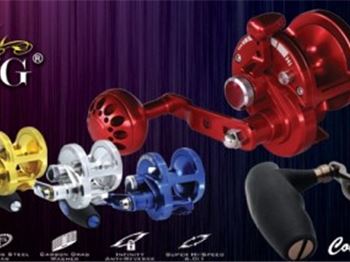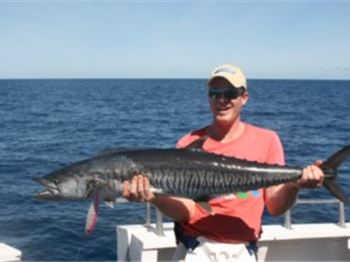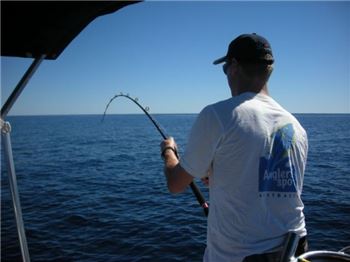Five tips to improve your surf fishing
Like all things there is never any substitute for experience, but there are a few simple things you can look into to improve your surf fishing. The five points below provide some simple advice for improving different aspects of your surf fishing.
1. Harden Up Baits
When soaking soft baits such as pilchards / mulies for larger fish like tailor, mulloway, salmon or gummy sharks sometimes it doesn't take long for baits to be stripped to the bone by small picking fish such as whiting or herring. Also sometimes you might find that baits are only lasting a few casts as once they've been in the briny for a little while they become water-logged and too soft to hold up through the action of the cast or the impact of the water.
Using salted baits is one way to get around these problems. Pilchards can be salted by yourself or many places sell them pre-salted. The salting process involves putting layer upon layer of salt on the fish until most of its moisture has been removed. This results in a tougher bait that is more resistant to the wear-and-tear of surf fishing.
Another option is to try using ghost cotton; a thin, white cotton that should be available at your local tackle store. Ghost cotton can be wrapped around the bait a few times to hold it together and to keep it tighter on the hook. This will strengthen the bait against the water's impact when it's cast and will also make it more difficult for any of those frustrating pickers to get away with your bait.

Slidebaiting is one method for increasing the distance you can cast
2. Pick Your Spots
Undertaking some reconnaissance of the beach you're going to fish from can greatly increase the likelihood of finding fish when you put a line in the water. Some beaches change shape on a regular basis. While the sand you're standing on might look the same as it did earlier on in the year, it's highly likely that under the water things are different. Wave, tide and rip action causes gutters and sandbars to move which then has an impact on where fish are.
Checking a beach at low tide or on a calm day can help reveal how the beach currently looks and where you should fish. If planning a night fishing session visiting the beach during the middle of the day can help identify where to park the car or how far to walk down the beach before casting out.
One of the ways to make this reconnaissance a lot easier is to:
3. Get some Polaroid glasses
There's no doubt that being able to identify any gutters or holes along the beach you're fishing will increase your chances of catching good fish. Polaroid glasses can greatly enhance your ability to do this by cutting the light's reflection off the water making it easier to clearly identify any changes in water colour - this may mean better identification of schooling fish such as salmon or baitfish, gutters, reef, weedy outcrops or if at a river mouth where the edge of the dirty water lies.
All anglers should have a pair of Polaroid glasses, even a cheap servo pair will make an amazing difference. Another option is of course to check out the multifunction Polaroid glasses available through Seabreeze (ask for the polarised model).

A tasty sized salmon sitting in the shallows - they're not always out in the deep!
4. Casting Too Far or Too Close?
It's easy to think that the further you cast your line the more likely you are to catch fish. At times, and depending on the species you're hunting, this can be correct, but sometimes it can sell you short.
As fish tend to congregate around structure and drop-offs the location of these can locations can sometimes be in quite close to the shoreline. Sometimes they can be right out the back of the location you are fishing. If you've undertaken Tip 2 of these five points you will know where to cast.
If you have trouble getting the distance you would like a number of things can help make a difference. 1) braided lines, read Tip 5 for more information; 2) check the spool on your reel is filled with line; 3) investigate slide-baiting, a method allowing you to cast the sinker only and send the bait out later; and 4) ask your tackle store about impact sinkers which allow the bait to be connected to the sinker thereby improving the rig's aerodynamic nature.
5. Understand Braid and Mono Line Differences
Braid and mono lines both bring advantages and disadvantages to fishing. When surf fishing it's valuable to be aware of these differences and the impact it has on what you're doing.
Braided lines have very little stretch. This can make it difficult to set a sinker when fishing in conditions with large or heavy wave actions. It may also increase the chance of being snapped off if you receive a heavy hit from a fish. Monofilament lines can circumvent these problems but in return you can lose bite sensitivity and casting distance.
Also while the flexibility of mono will allow for some give through the impact of a wave, its larger diameter, sometimes up to twice the diameter of a braided line, can create issues. Due to the larger diameter the line tends to catch more of the wave impact as well as the wash of the current under the water.
Braided lines also have a low tolerance to abrasion. This means if you're fighting a fish and it takes you to the reef or rocks, braid is likely to give way a lot quicker than mono line will. This can be easily fixed by using a mono leader which will provide that protection needed in these sorts of areas.
This article was written for Seabreeze courtesy of Ajiking Pro Game Fluoro Leader





